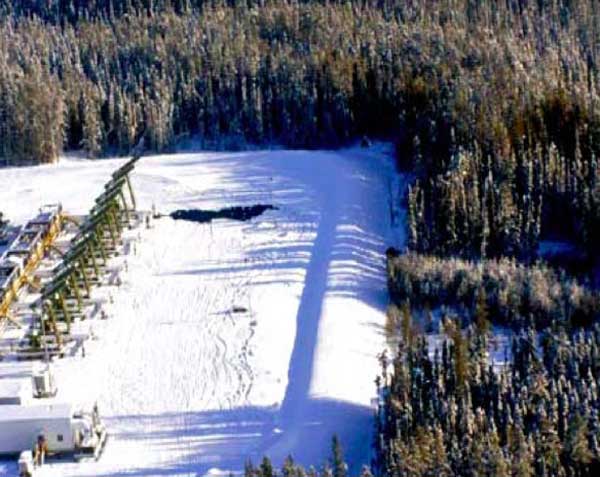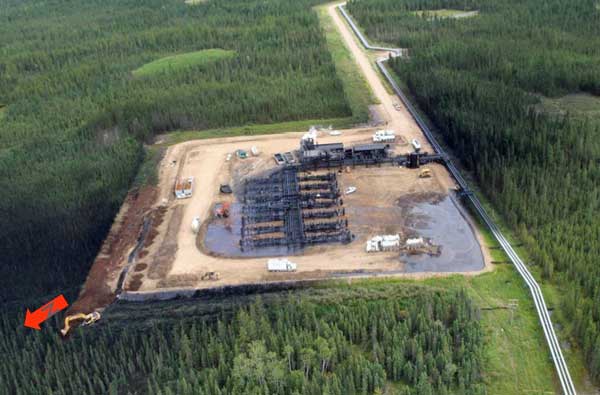A recent blow-out at Canadian Natural Resources Ltd.'s Primrose facility in northern Alberta sheds light on a serious but little discussed topic in the oil sands industry: caprock integrity.
The blow-out allowed more than 10,000 barrels of steamed bitumen to seep into the boreal forest through ground fissures as long as 159 metres, putting groundwater at risk.
While highly technical, the issue is a critical one, with high stakes for investors and the province alike.
Approximately 80 per cent of Alberta's bitumen deposits lie deeper than 75 metres and cannot be mined. As a consequence, these deep deposits, all capped by rock, are currently being heated to as high as 300 degrees Celsius with highly pressurized steam.
Industry uses either a steaming tool called steam-assisted gravity drainage or cyclic steam stimulation to melt a resource as hard as a hockey puck.
The overlaying caprock acts as a primary but not always impermeable seal that keeps steamed bitumen from seeping into aquifers, neighbouring industry wellbores and other geological formations, as well as the forest floor and lakes.
In general, industry tries to keep the pressure significantly low enough to ensure the caprock does not break -- but high enough to push the melted bitumen out.
It is a very fine line. In 2006, French multinational company Total blew a 300-metre crater in the forest while trying to steam up a shallow formation of bitumen.
Although regulatory reports on the event weren't published until four years later, the "catastrophic event" put caprock integrity on the agenda and forced Total to abandon its project.
Ever since then, all steam-based bitumen operations, the industry's most energy-intensive facilities, report yearly on caprock integrity. The Society of Petroleum Engineers devoted a sold-out workshop on the subject last spring in Banff.
Given that there are more than 100 steam plant facilities poking thousands of holes into irregular layers of bitumen, there is "a need to improve the collective capabilities of operators, service providers and regulatory bodies in the area of caprock integrity management," noted the event's organizers.
This heightened interest explains why Environment Canada is now investigating Canadian Natural Resources Ltd.'s blow-out, which involved four different well locations.
Regulator denies public review
The event, not the first of its kind as a Tyee investigation reveals, killed wildlife, polluted a small lake and seeped nearly 20 barrels of bitumen a day into muskeg over the last five months.
The company suggests that the cause of the bitumen seepage may be due to "mechanical failures of wellbores in the vicinity of the controlled areas." But others say it's possible the company broke the caprock or connected with existing fractures in the rock.
The blow-out also explains why 23 different groups asked for a public review of safety regulations for steam plant operations last August.
The Alberta Energy Regulator denied the request, saying that "[cyclic steam stimulation] and high pressure cyclic steam stimulation have been successfully used as bitumen recovery techniques in Alberta for many years" and that a public inquiry would "not provide any new information that may be able to support or guide regulatory change." Steam-assisted gravity drainage has a 13-year commercial history in Alberta.
Yet the same regulator created a special Oilsands Caprock Integrity Project (OCRIP) five years ago. OCRIP's website specifically warns that "uncontrolled releases of steam, oil or formation water caused by in situ oil production (e.g. cyclic steam stimulation and steam-assisted gravity drainage) create concerns for resource and environmental conservation."
OCRIP has yet to publicly release a promised analysis of "human-induced geological hazards" in the region, as well as an incident review database of steam operations that have broken the caprock.
Echos of fracking
Recent studies by petroleum scientists as well as annual industry progress reports to the Alberta Energy Regulator show that the technologies used to steam deep bitumen deposits have created the same sort of problems now plaguing the hydraulic fracturing of unconventional oil and gas resources across North America.
Both technologies inject highly-pressurized fluids into formations where the resulting pressure can crack or fracture overlying rock and well casings in unpredictable ways. These fractures can bring fluids or gases to the surface, contaminate groundwater or connect with other existing wells.
The end result for both technologies are the same: hydrocarbons go where regulators don't want them or industry can't control them.
Alberta regulators described the Total blow-out as a fracking issue in a 2011 presentation. "Given ongoing caprock integrity concerns associated with fracturing and hydro-fracking in the subsurface to initiate production, these findings will have relevance to other shallow thermal and non-thermal operations, including in-situ bitumen/extra-heavy oil operations, and production of other emerging unconventional commodities such as tight oil and shale gas."
The problem seems most pronounced at cyclic steam operations such as those run by Canadian Natural Resources Ltd. and Imperial Oil, where steam is injected into the ground for weeks at a time from pads that typically contain as many as 20 wells. After a soaking period, melted bitumen is brought to the surface.
EGS, an Ontario-based seismic monitoring company, notes this method is "environmentally sensitive and many risks exist for environmental damage during [cyclic steam operations]."
In particular, "Well casings are subject to severe tensile stresses due to the high temperature, high pressure nature of the [cyclic steam stimulation] process. These stresses have the potential to result in mechanical failures such as cement cracks or casing shear leading to well downtime, damaging spills or hazardous blowouts. Shear stresses also develop during the dilation of the reservoir during the steam injection, potentially causing the incursion of fluids into the overlying shales and aquifers above the caprock and causing environmental contamination and costly clean up and regulatory penalties."
A 2010 study by Devon Canada reported that as of 2009, more than one-third of all well casing failures in the province took place at steam plant operations in the oil sands. Of 4,920 reported failures to the regulator, 1,715 occurred on cyclic steam service and 22 in steam-assisted gravity drainage operations largely due to intense pressure and heat.
According to the Canadian Association of Petroleum Producers, a well casing that fails above the producible hydrocarbon bearing zone could shoot fluids or gases into local aquifers and "damage a fresh groundwater source."
A 2011 paper written by employees of Schlumberger, an oil servicing multinational, warned that continuous steam injection can deform a bitumen formation so badly that it can "reduce rock strength, induce new fractures or re-activate existing fractures posing contained risk of containment of breach of caprock."
In turn, the fracturing of caprock "can provide pathways for bitumen and steam to flow to aquifers or to the surface causing significant risk to safety and the environment," warned the paper.

Without complicated geomechanical modeling, operators won't be able to "proactively plan and take preventive measures to avoid any catastrophic events which can force [companies] to stop production or even abandoning of operations."
In applications to the regulator, companies admit that natural fractures are common in rock above bitumen formations south of Fort McMurray.
One 2013 Cenovus submission reported that existing fractures in the caprock by a proposed installation were numerous: an average of 1.5 to two fractures per well were identified. The company added that "it is extremely unlikely that there would be any ability for these fractures to connect."
In 2008, one of Canada's preeminent petroleum engineers, the University of Waterloo's Maurice Dusseault, warned that there was greater need for better quality monitoring at Alberta's bitumen steam projects given the complex nature of reactions that occur when highly-pressured hot steam meets cold rock 500 metres below the ground.
As steam heats, expands and dilates layers of bitumen, it often heaves the overlaying ground by 60 to 120 millimetres. The resulting stresses can fracture the overlying shales or find weaknesses in the caprock, noted Dusseault.
"This shearing is not favourable, as it is sufficiently large to collapse any penetrating well. Projects such as the Imperial Oil Cold Lake [cyclic steam stimulation] project experience dozens of well shear events yearly; these wells must be repaired or replaced at considerable cost," reported Dusseault.
Dusseault said that he could not talk to The Tyee about the problem because he is now advising the government of Alberta on what to do about caprock integrity issues.
Issues 'not talked about openly'
New techniques being developed for bitumen recovery can also fracture the caprock as effectively as cyclic steam stimulation. A 2013 study on the use of electrodes to heat up shallow deposits of bitumen found that these systems could destroy the seal of the caprock.
Explained the study: "In extreme cases, the water boils, and the pore pressure increases dramatically as a result of the phase change in the water, which causes profound effective-stress reduction. After this condition is established, pore pressure increases can lead to shear failure of the caprock, the creation of microcracks and hydraulic fractures, and subsequent caprock integrity failure."
"I think the issue is taken very seriously by industry, even if it is not talked about openly," Rick Chalaturnyk said in an email exchange. He's one of the study's authors, as well as the Foundation CMG Chair in Reservoir Geomechanics at the University of Alberta.
Steam operators now submit studies on caprock integrity with their applications but "whether the Alberta Energy Regulator has the right skills set or understanding to effectively manage these issues is a whole separate question," Chalaturnyk said.
In addition to caprock integrity, Alberta's steam plants have experienced chronic cost overruns, pollution issues from hydrogen sulfide and poor production records due to the rising amount of steam needed to extract one barrel of bitumen.
The carbon footprint of steam production methods is three times greater than that of mining projects and their impact on land is nearly double that of open pit mines due to their extreme consumption of natural gas. Energy returns for the projects match the poor returns of biofuels such as ethanol.
A CAPROCK CHRONOLOGY
Texaco/1980s/Fort McMurray
In the early 1980s, Texaco experimented with steaming bitumen deposits with a Fort McMurray thermal pilot. "They had a blow-out and the steam geyser looked like Yellowstone" reported Glen Schmidt, CEO of Laricina Energy, to the Edmonton Journal last year.
Imperial/1988/Cold Lake
High pressure steam from a cyclic steam stimulation operation broke through an abandoned oil sands evaluation well and spilled more than 6,000 barrels into the forest, along with 4,000 barrels of toxic water laden with chlorides. The blow-out temporarily contaminated three shallow aquifers with chlorides. The company trucked more than 22,000 barrels of bitumen, water and peat to the landfill.
Total/2006/Joslyn
French multinational Total blasted a 300-metre crater in the boreal forest that created a one-kilometre-long dust plume during the beginning of a new steam-assisted gravity drainage operation. (Most caprock failures occur after five to seven years of pressurized steam injection.)
Four years later the regulator called the explosion "catastrophic." The regulator concluded that Total exceeded pressure limits and "was in noncompliance with scheme approval."
Steam then pooled below the caprock and erupted through a fracture or abandoned well. There is no conclusive identification of the cause of the failure. Nevertheless, the event illustrated that the energy available from water and steam can be formidable.
With the exception of Mike Carlson, little has been written about this event. The Calgary engineer found that "there is virtually nothing from an engineering perspective on the caprock failure at Joslyn in the peer-reviewed technical literature." He concluded in a 2012 paper that the problem for the Total blow-out has not been fully determined.
"The Joslyn failure is a significant catastrophic failure affecting [steam-assisted gravity drainage] developments. Future licensing of [these] projects will be uncertain if the cause of failure is not known with certainty." The event rendered nearly 30 million barrels of bitumen unrecoverable. Total abandoned its steam plant project and opted for a surface mine instead.
CNRL/2009/Primrose East
At Primrose East, Canadian Natural Resources Ltd. injected high-pressure steam into 80 wells at four pads. At two well sites bitumen steamed to the surface and through two thin surface fissures on the ground in the dead of winter. The company eventually removed more than 12,000 tons of bitumen, water, snow and muskeg to the landfill.
The seepage event contaminated the Bonnyville Aquifer. "There remains uncertainty about how the bitumen emulsion will break down over time with heat from further steam injection and about what constituents may be released into the Bonnyville Aquifer," reported the regulator five years after the vent in 2013.
Neither the regulator nor CNRL could agree on the cause of the bitumen seepage. Noted the regulator: "A contributing factor in the release may have been geological weaknesses in combination with stresses induced by high-pressure steam injection."
Devon/2010/Jackfish:
In 2010, bitumen-laden steam burst 30 metres into the air at a steam-assisted gravity drainage well operated by Devon near Conklin, Alberta. The blow-out, which closed seven wells, was caused by a "catastrophic erosional wear" at the wellhead due to an unusual amount of sand production. It took nearly five days to control the steam release that poured nearly 300 cubic metres of bitumen and nearly 1,000 cubic metres of water on the surface. The company later blamed the event on failure to understand the gravity of sand erosion and lack of planning for well failure.
Imperial Oil/2013/Cold Lake
Every year Imperial Oil experiences well failures at its cyclic steam operation in Cold Lake, where approximately 3,000 wells produce 150,000 barrels of bitumen a day. The steaming causes the ground to heave, breaks well casings and can result in spills and blowouts swallowing entire well pads. In 2008, engineer Maurice Dusseault reported that tearing at the caprock occurs routinely at Imperial's cyclic steam stimulation project and it "experiences dozens of well shear events; these wells must be repaired or replaced at considerable cost." Casing well failure is routine in Cold Lake. A 2002 study found that 92 out of 585 wells on 22 pad sites failed over a five-year period.
Recent In Situ Progress Presentations to the Alberta Energy Regulator reveal a myriad of problems. Steam from Imperial's wells has travelled through fractures and broken into bitumen formations owned by Husky. Steam has also moved from a depth of 420 metres in the Clearwater formation to shallower formations closer to the surface, such as the Grand Rapids and Colorado shales. This "interzonal communication" can affect groundwater.
As a consequence of assorted fractures, well casing failures and leaks, Imperial is now investigating levels of benzene, toluene and ethylbenzene that exceed Canadian Drinking Water Guidelines in local groundwater. Imperial also reports numerous "bitumen in shale" incidents, where steamed bitumen finds its way into groundwater aquifers at depths of 153 metres or nearly 400 metres away from the target formation.
Steam has mobilized arsenic in the region and forced an elaborate groundwater monitoring program. ![]()
Read more: Labour + Industry, Environment
















Tyee Commenting Guidelines
Comments that violate guidelines risk being deleted, and violations may result in a temporary or permanent user ban. Maintain the spirit of good conversation to stay in the discussion.
*Please note The Tyee is not a forum for spreading misinformation about COVID-19, denying its existence or minimizing its risk to public health.
Do:
Do not: